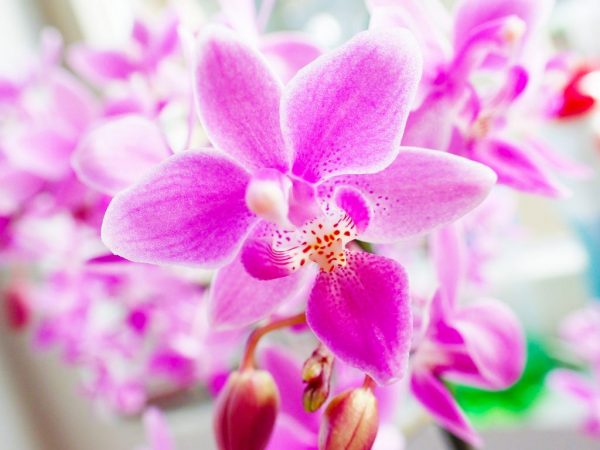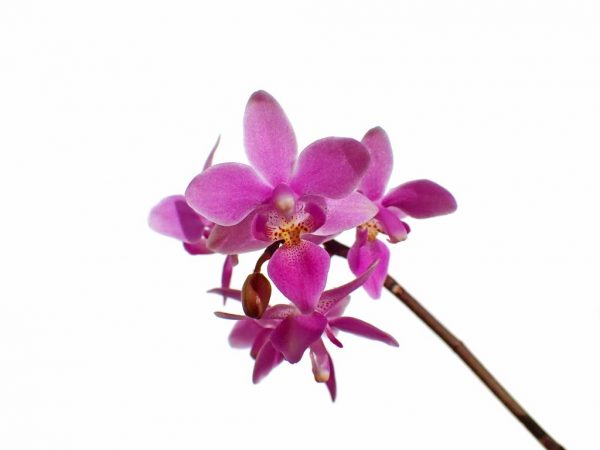Description of orchids phalonopsis Equestris
Orchids are one of the finest decorative flowers that require careful maintenance. Breeders have bred hybrid varieties that are comfortable for home care and growth, one of these species is the Equestris orchid.

Description of orchids phalonopsis Equestris
External description of the flower
Phalaenopsis Equestris, from lat. Phalaenopsis equestris is a herbaceous plant of the Orchid family. This is a hybrid look for home content.
Equestris is a miniature tree with small peduncles. The stem is short and branched, the leaves are succulent, thanks to which moisture is easily collected and absorbed.
The root system is airy and compacted. Has a thick velamen layer. The roots contain chlorophyll, so some of their parts are green.
Leaves and peduncles
Leaves are oval or oblong. Length no more than 16 cm, width up to 7 cm and thickness no more than 3 mm. The structure is dense, slightly fleshy. On the outside they are dark green, inside the leaf is reddish.
The plant produces several stems, dark purple in color. The height of each varies from 13 to 32 cm. On the peduncle, up to 15 pieces. small flowers. Each of them is 18 - 35 mm in diameter, round in shape.
The plant has a large palette of colors. Colors range from white, light pink to deep lilac. The lip of the plant is beardless and several shades darker than the main color.
How the plant blooms
There are two main flowering periods - spring and autumn. During these periods, the plant consistently produces several peduncles. They gradually grow, give new buds. This process significantly increases the flowering time. Therefore, phalaenopsis equestris blooms for months.
This species is capable of blooming in any other period. Proper care and comfortable living conditions will have a beneficial effect on the general condition.
Equestris orchid subspecies

Orchids are very diverse
The orchid has several hybrid subspecies:
- Blue. Peduncles of lilac color with a blue tint. Differs in long flowering, up to 9 months.
- Alba. Miniature subspecies. The leaves are narrow, the color is white. It also has a long flowering period.
- Grasse. The flower is medium in size. The color is lilac, the shape is oval. Differs in a large number of flowers on each peduncle.
There are several more subspecies of this plant, the three presented are the most popular of all.
Growing
The plant is a little capricious in care and living conditions. You need to devote enough time to provide it with everything you need. You need to start with the correct fit.
Landing
Planting a plant begins with the correct selection of soil. The optimal type of soil is a ready-made mixture for home planting. If you can't find one, you can cook it yourself:
- charcoal;
- components of inert origin (polystyrene, perlite, etc.);
- steamed pine tree bark;
- moss.
Inaccurate composition of ingredients can damage the root system.
Planting capacity
The orchid is planted in plastic containers, after having washed them. The pot should have a large number of holes that will allow air to pass through.
It is better to take the container transparent, so the sun's rays will fully warm the root system even in the depths of the pot. The size should be matched to the volume of the root, but slightly larger than it, by 2-3 cm.
Growing by seeds
Planting a plant with seeds is a laborious process. After the seeds have sunk into the ground, the container is tightly closed. The first shoots appear 9 to 10 months after planting. After 2 years, the plant is transplanted into a permanent pot.
Rostkom
Phalaenopsis orchids cannot be propagated by plucking the rhizome. For this species, it is necessary to use propagation with the help of new shoots. The separated bulb should have 3 leaves and a root length of at least 4 cm. The shoot is placed in a special plastic pot and the usual care of the plant begins.
Plant care
General requirements

Compliance with humidity and light is required
Hybrid species are not the most demanding to care for, but there are general rules for full growth and development:
- room temperature 20 - 22 C °;
- direct exposure to sunlight is prohibited;
- adequate lighting;
- air humidity 45 - 65%.
The flower loves fresh air, but is afraid of drafts. It is also necessary to prune the stalks after they have completely bloomed.
Transfer
An important step in caring for a plant is its transplant. The main thing is to properly remove the root system from the pot without damaging it. Roots often stick and grow into the substrate.
Gently cut off rotten roots and treat with dry powder of activated carbon or cinnamon. Drainage is laid at the bottom of the pot. Carefully place the flower in it, cover it with earth and straighten it.
Fertilization and watering
The flower needs deep and long-term hydration. Next, the root must be completely drained. It is better to put the pot in a container of water for a few minutes. For irrigation, use pure or melt water.
Top dressing is added at every 4 - 5 watering of the plant. Fertilizers are used only special, intended for indoor orchids.
Diseases and pests
Hybrid phalaenopsis is little susceptible to diseases and pests. Most often, problems appear against the background of improper care or composition of the soil, fertilizer or a diseased plant in the neighborhood.
Fight disease
First of all, it is necessary to remove neighboring plants away from the infected one. Review the time and amount of watering, saturation with sunlight, temperature conditions. Additional mixtures from various kinds of diseases will help to cope in the initial stages of the disease.
Pest control
They fight pests with ready-made solutions, such as Fitoverm. It is important to use the drug strictly according to the instructions. Processing is carried out only from the moment the pest appears.
Prophylaxis
The only prevention of an orchid is proper care. Fulfillment of basic requirements will relieve and protect from any misfortune.
Conclusion
Hybrid orchid species, including the Phalonopsis Equestris, are very popular because they are less demanding to care for. It is not difficult to grow a beautiful plant at home.


